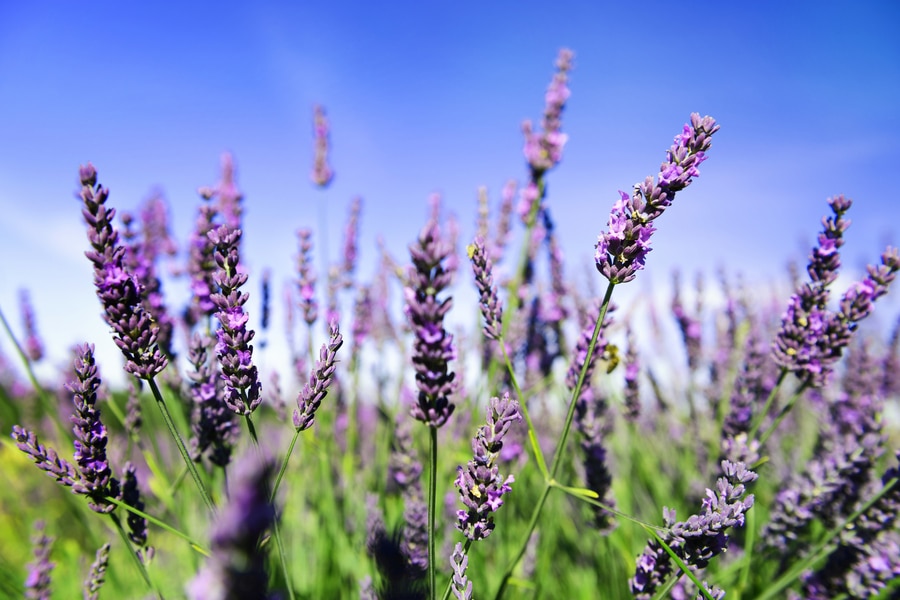
We’ll tell you how to plant, cultivate, and harvest lavender in the garden below.
About Lavender Plants
It has grey-green foliage and upright flower spikes in different tones of purple, white, and pink. Lavenders are partly woody plants distinguished by their square-shaped stems and evergreen leaves.
The commonly-grown lavender is the English lavender or Lavandula angustifolia.
Common Types Of Lavender
Lavender flowers can grow all season in some tropical climates and will usually late spring to early summer is its bloom time.
English Lavenders
Spanish Lavender
French Lavender
Portuguese lavenders
Lavandin
How To Plant Lavender?

Preparing The Plant Lavender
After you’ve picked a spot for your new garden of lavender, think of which varieties you want to grow. With bountiful lavender available, you can choose between different flower colours, bloom times, sizes, and hardiness. Bearing these options, the next step is designing a lavender garden design.
Factors of colour, arrangement, and balance can be incorporated when making a striking lavender garden design. The soft mauve-blue palette and lovely fragrance of lavender, as well as the buzz of bees flying over the flowers, are a divine complement to any garden. If you’re aiming for a sea of lavender, buy all of the same variety.
Proper spacing is also vital, specifically in wet or humid environments. Give it enough elbow room to accommodate flowers. Plant lavender plants 2 to 3 feet apart as they grow between 1 and 3 feet tall.
It is often suggested that you first plant small test spots to know what works best in your setting. Your local cooperative extension can guide you, as well.
In the garden, lavender makes an excellent herb along a pathway, in zone flower beds, rock gardens, around benches, or even as border steps. Every time you pass these areas, you’ll smell its pleasant aroma. No matter your garden style, there’s always room for some landscaping with lavender.
When To Plant Your Dark Purple Flowers?
If growing lavender in the fall, opt for larger, more established plants to guarantee their vitality through the winter, or perhaps plant them at least eight weeks before the average frost date.
How To Care for Lavender?
Base Of The Plant
Watering
Fertilizing
The only mineral fertilizer your lavender may want is calcium (via eggshells or agricultural lime). Eggshells possess the extra value of making the soil more alkaline.
Temperature & Humidity
Another alternative for cooler climates is to cultivate lavender in a pot, placing inside in winter and outdoors in the summer. When indoors, position the pot in a south-facing window with as much light as probable. Water sporadically since the plant will be inactive at this period.
Pruning Lavender
Prune lavender by about one-third (1/3) of its height to promote new growth. As plants grow, the lower stems get woody. Locate the woody part of the stem and measure about 2 inches upward, then cut. Do not trim into the old wood because it will not regrow.
Clip faded flower stems back throughout the blooming season to facilitate repeat flowering.
How To Harvest Lavender

Gather into small bunches and tie them with rubber bands. Hang them upside-down in a warm spot with good air circulation until dried.
Work with your dried lavender to make lavender sachets. Lavender sachets can keep your linens or towels smelling good, hold moths and insects off, and even help you have a relaxing night. You can also utilize the dried flowers in the kitchen.
Propagating Lavender Plant
From Seed
Lavender seeds can be planted straight in the garden soil, though they sprout much more successively when sown indoors in a seed tray. Use a light, seed-specific potting mix, and gently cover each seed with a thin layer of soil. Lavender grows faster when exposed to the sun, so don’t cover them completely.
Your lavender seedlings will be ready to transplant as soon as they bear several leaves per plant. Your first year of growth will not be exceptional but anticipate immense flowering lavender by year two.
By Softwood Cuttings
To take a softwood cutting, opt for a bright green stem on which flower buds have not yet started to develop. With a sharp, clean knife or garden shears, snip stems measuring 4 to 8 inches long, clipping just below a leaf node.
Strip all the leaves from the lower 2-3 inches and carefully scrape the skin off the bottom part of the stem on one side using a knife. Set the trimming aside as you set up the container.
Add your favourite drainage material, like tiny pebbles, gravel, coconut coir, coffee filters, or broken pottery, to a 6-inch pot, then load it with a commercial potting medium or create your mixture.
Dip the cut end of each cutting into the rooting hormone. Embed a couple of cuttings around the border of small containers of gritty compost. Ensure that the part cutting without leaves is fully implanted and that the lavender is standing up straight.
Water the compost thoroughly, then cover the entire pot with a clear polythene bag to keep the humid conditions around the cuttings.
By Hardwood Cuttings
To take a hardwood cutting, find a green growing leaf end and then follow the stem down to the brown woody part. Clip the stalk at an angle around 1 to 2 inches beneath the green softwood. Get rid of the lower foliage that extends on the woody part.
The cuttings must be approximately 4 to 6 inches long. Scour a little woody skin from the lower end and dip them in a rooting solution to have a higher success rate.
Put hardwood cuttings in a container, up to 4 inches deep. Nurture them as you did with softwood cuttings. Wait 4 to 6 weeks for them to set roots before transplanting. You can give stems a very gentle pull to see if they have begun growing roots.
Repotting Lavender
Lavender favours growing in a cramped space. A pot that can house the root ball with a few inches to provide is the right choice; an awfully big pot will only promote extreme dampness.
See to it that your container contains enough holes at its base for good drainage. Further, you can grow lavender in a terracotta or clay pot to help absorb moisture from the soil and prevent it from becoming too watery. Use a loose, soilless mix for planting, and note that container-grown lavender will need more water than garden-cultivated plants.
A good standard is to water when you have dry soil, rinsing at the footing of the plant to reduce moisture on the green foliage.
Common Pests & Plant Diseases
They may develop phytophthora, which is a soil-borne fungal condition that leads to stem and root rot. Lavender can also suffer from septoria leaf spot, which is induced by a fungus and is also typically seen on tomato plants. Other common diseases are xylella, and alfalffa Mosaic Virus.
The primary pests of lavender are Septoria leaf spot, garden fleahopper, and four-lined plant bug; however, a few more little pests are also recognized, like woolly bear caterpillars, leafhoppers, tarnished plant bug, and spittlebug.
Other pests include woolly bear caterpillars and grasshoppers, though these do not cause significant damage to the plants. Grasshoppers will cause some chewing damage though only a minor amount.

Final Thoughts
If you exert the effort into growing lavender plants properly, it will reward you with numerous years of enchanting blossoms without much demand for care.
Colin Macmillan is a seasoned entrepreneur and the CEO of Riverwood Landscape, a leading landscaping company based in Canada. He has been at the helm of the company since leaving high school, demonstrating his strong leadership skills and business acumen.
Colin’s expertise lies in various aspects of landscaping, including lawn care, interlocking, sod installation, and commercial maintenance. His hands-on approach and dedication to the craft have been instrumental in building Riverwood Landscape into a reputable brand.
One of his most notable achievements is the creation of a successful landscape franchise that services multiple locations. This accomplishment underscores his strategic thinking and ability to scale operations effectively.
Colin has also had the privilege of working with Guelph Hospital for landscaping and maintenance, a testament to the trust and reliability that his company has earned over the years.
His professional mission is to offer the best services and experiences for customers, a goal that he tirelessly pursues. Colin’s commitment to excellence and customer satisfaction continues to drive the growth and success of Riverwood Landscape.








